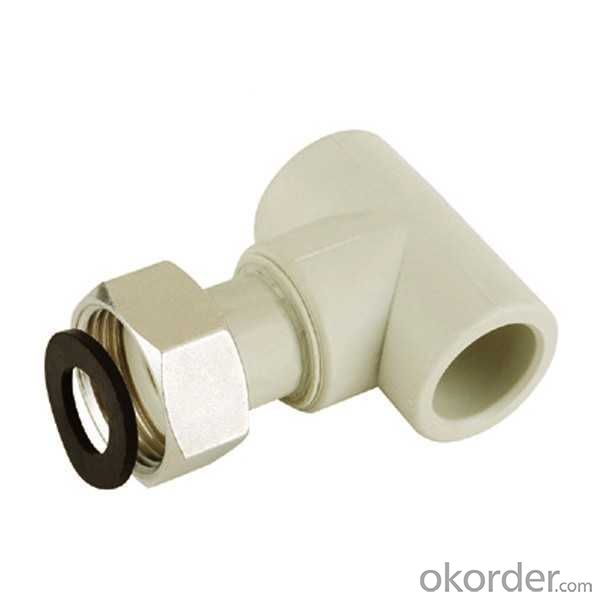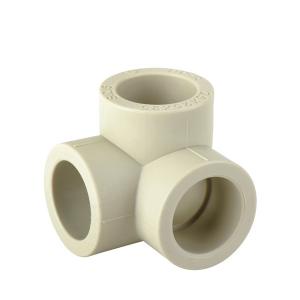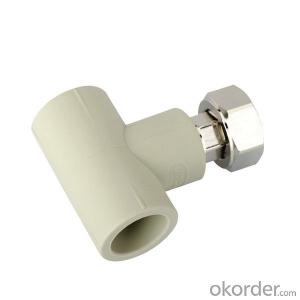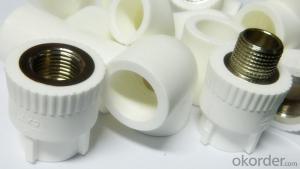28mm High Quality Tee-Plastic Threaded Union Pipe Fittings
- Loading Port:
- Ningbo
- Payment Terms:
- TT or LC
- Min Order Qty:
- 1000 watt
- Supply Capability:
- 100000 watt/month
OKorder Service Pledge
Quality Product, Order Online Tracking, Timely Delivery
OKorder Financial Service
Credit Rating, Credit Services, Credit Purchasing
You Might Also Like
 ppr fittings HYOSUNG PPR raw materials standard:DIN8077-8078 GB/T18742.3-2002 PN25 White grey green color
ppr fittings HYOSUNG PPR raw materials standard:DIN8077-8078 GB/T18742.3-2002 PN25 White grey green color
1.Material:Random Polypropylene(Hyosung R200P);
2.ISO9001&ISO14001;
3.Standard:GB/T 18742.3-2002, DIN8077/8078;
4.OEM also ok
- Q: How do plastic pipe fittings differ from metal pipe fittings?
- Plastic pipe fittings differ from metal pipe fittings in several ways. Firstly, plastic fittings are generally more affordable compared to metal fittings. Additionally, plastic fittings are typically lightweight and easier to install, while metal fittings can be heavier and require more effort for installation. Plastic fittings are also resistant to corrosion and rust, which can be a concern with metal fittings. However, metal fittings generally have higher heat tolerance and are more durable in certain applications. Ultimately, the choice between plastic and metal fittings depends on the specific needs and requirements of the plumbing or piping system.
- Q: Can plastic pipe fittings be used for rainwater collection systems?
- Yes, plastic pipe fittings can be used for rainwater collection systems. Plastic fittings are commonly used in these systems due to their durability, affordability, and resistance to corrosion.
- Q: Are plastic pipe fittings suitable for both residential and commercial applications?
- Yes, plastic pipe fittings are suitable for both residential and commercial applications. They are commonly used in both settings due to their durability, affordability, and ease of installation. Additionally, plastic pipe fittings are resistant to corrosion and chemicals, making them a reliable choice for various plumbing needs in both residential and commercial buildings.
- Q: Can plastic pipe fittings be used for cooling water in power plants?
- Yes, plastic pipe fittings can be used for cooling water in power plants. Plastic pipes and fittings, such as PVC or HDPE, are commonly used in various industrial applications, including power plants. They offer several advantages such as cost-effectiveness, corrosion resistance, and ease of installation. However, the specific choice of materials should consider the temperature and pressure requirements of the cooling water system to ensure proper performance and durability.
- Q: Why does methanol corrode plastic pipes?
- Resins, nylon and rubber, especially nitrile (Ding Jing rubber), ethylene propylene rubber, polytetrafluoroethylene and neoprene, are ideal materials for methanol treatment and storage equipment.
- Q: Can plastic pipe fittings be used for water descaling systems?
- No, plastic pipe fittings are not typically recommended for water descaling systems due to their potential to degrade or react with the chemicals used in the descaling process. Metallic fittings are generally preferred for their durability and resistance to corrosion.
- Q: Can plastic pipe fittings be used for chemical injection skids?
- Yes, plastic pipe fittings can be used for chemical injection skids. Plastic pipe fittings are often preferred for chemical injection skids due to their corrosion resistance, durability, and cost-effectiveness. However, it is important to consider the compatibility of the plastic material with the specific chemicals being injected to ensure proper functioning and safety.
- Q: What is the maximum temperature that plastic pipe fittings can withstand?
- The maximum temperature that plastic pipe fittings can withstand depends on the type of plastic used. Generally, PVC (polyvinyl chloride) fittings can handle temperatures up to 140°F (60°C), while CPVC (chlorinated polyvinyl chloride) fittings can withstand temperatures up to 200°F (93°C). However, it is important to refer to the manufacturer's specifications for the specific plastic pipe fittings being used to ensure accurate temperature limits.
- Q: Can plastic pipe fittings be used in sprinkler systems?
- Yes, plastic pipe fittings can be used in sprinkler systems. They are commonly used due to their durability, affordability, and resistance to corrosion. Additionally, plastic fittings are easier to install and require less maintenance compared to traditional metal fittings.
- Q: Can plastic pipe fittings be used for sewer systems?
- Yes, plastic pipe fittings can be used for sewer systems. Plastic materials such as PVC (polyvinyl chloride) and ABS (acrylonitrile butadiene styrene) are commonly used in sewer systems due to their durability, corrosion resistance, and affordability. Plastic pipe fittings are designed to connect and secure plastic pipes, offering a reliable and long-lasting solution for sewage transportation.
Send your message to us
28mm High Quality Tee-Plastic Threaded Union Pipe Fittings
- Loading Port:
- Ningbo
- Payment Terms:
- TT or LC
- Min Order Qty:
- 1000 watt
- Supply Capability:
- 100000 watt/month
OKorder Service Pledge
Quality Product, Order Online Tracking, Timely Delivery
OKorder Financial Service
Credit Rating, Credit Services, Credit Purchasing
Similar products
Hot products
Hot Searches
Related keywords
























